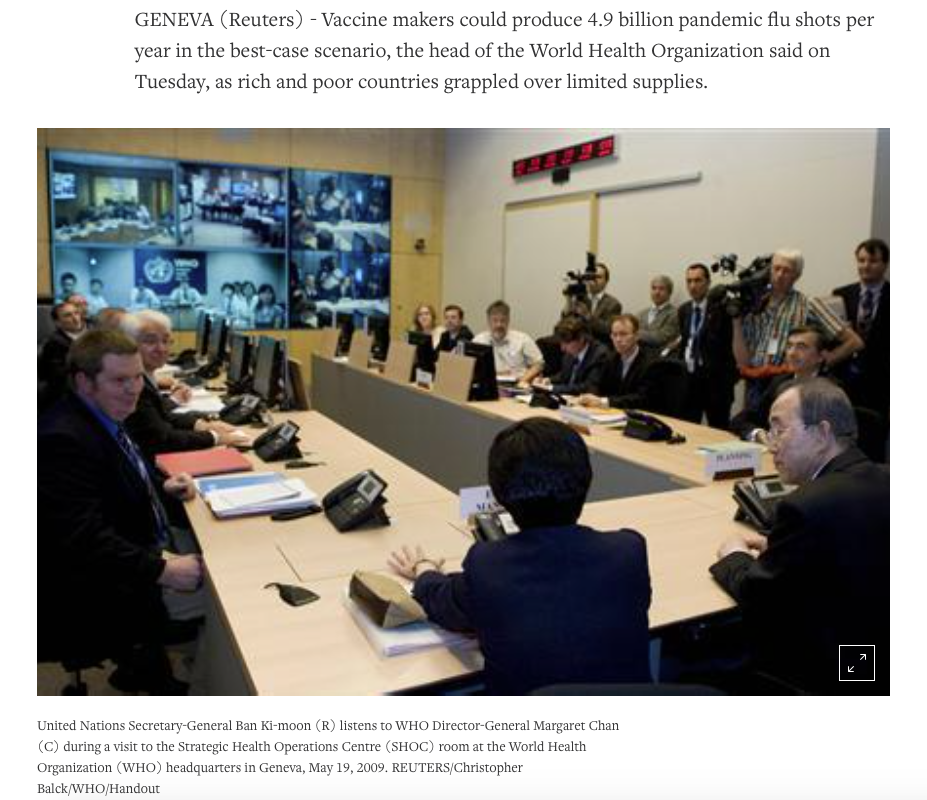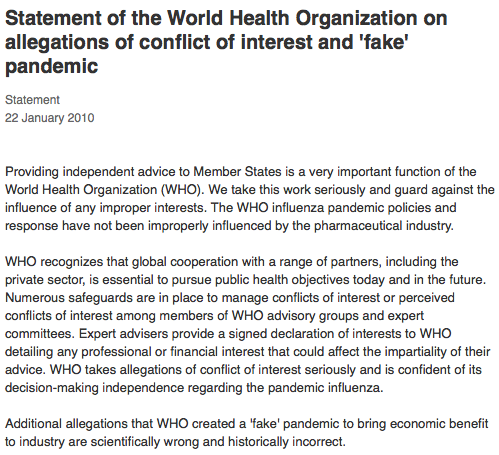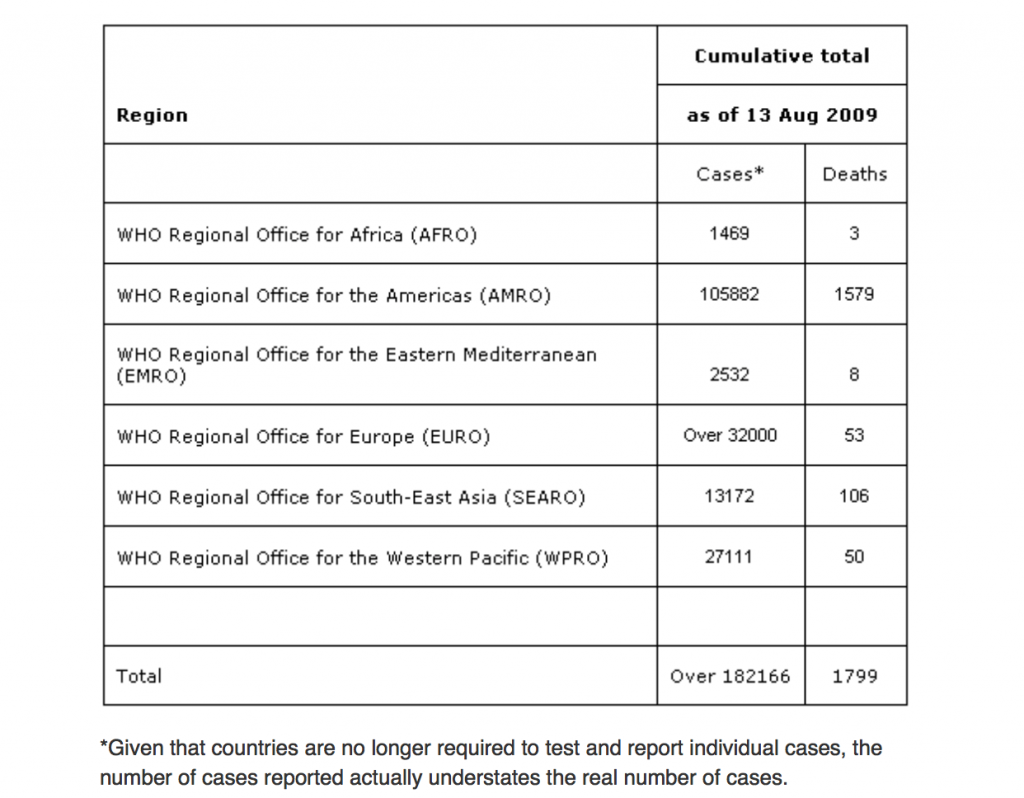Remember the “Fake” 2009 H1N1 Swine Flu Pandemic: Manipulating the Data to Justify a Worldwide Public Health Emergency
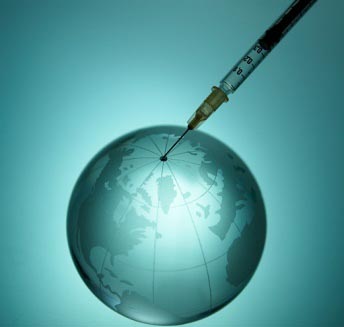
Author’s Introduction
Déjà Vu
Remember the unusual circumstances surrounding the April 2009 H1N1 Swine Flu Pandemic.
Media disinformation. An atmosphere of fear and intimidation. Corruption at the highest levels. The data was manipulated.
In July 2009, the WHO Director General predicted with authority that: “as many as 2 billion people could become infected over the next two years — nearly one-third of the world population.” (World Health Organization as reported by the Western media, July 2009).
It was a multibillion bonanza for Big Pharma supported by the WHO’s Director-General Margaret Chan.
In June 2009, Margaret Chan made the following statement:
“On the basis of … expert assessments of the evidence, the scientific criteria for an influenza pandemic have been met. I have therefore decided to raise the level of influenza pandemic alert from Phase 5 to Phase 6. The world is now at the start of the 2009 influenza pandemic. … Margaret Chan, Director-General, World Health Organization (WHO), Press Briefing 11 June 2009)
What “expert assessments”?
In a subsequent statement she confirmed that:
“Vaccine makers could produce 4.9 billion pandemic flu shots per year in the best-case scenario”,Margaret Chan, Director-General, World Health Organization (WHO), quoted by Reuters, 21 July 2009)
A financial windfall for Big Pharma Vaccine Producers including GlaxoSmithKline, Novartis, Merck & Co., Sanofi, Pfizer. et al.
Fake News, Fake Statistics, Lies at the Highest Levels of Government
The media went immediately into high gear (without a shred of evidence). Fear and Uncertainty. Public opinion was deliberately misled
“Swine flu could strike up to 40 percent of Americans over the next two years and as many as several hundred thousand could die if a vaccine campaign and other measures aren’t successful.” (Official Statement of Obama Administration, Associated Press, 24 July 2009).
“The U.S. expects to have 160 million doses of swine flu vaccine available sometime in October”, (Associated Press, 23 July 2009)
Wealthier countries such as the U.S. and Britain will pay just under $10 per dose [of the H1N1 flu vaccine]. … Developing countries will pay a lower price.” [circa $40 billion for Big Pharma?] (Business Week, July 2009)
But the pandemic never happened.
There was no pandemic affecting 2 billion people…
Millions of doses of swine flu vaccine had been ordered by national governments from Big Pharma. Millions of vaccine doses were subsequently destroyed: a financial bonanza for Big Pharma, an expenditure crisis for national governments.
There was no investigation into who was behind this multibillion dollar fraud.
Several critics said that the H1N1 Pandemic was “Fake”
The Parliamentary Assembly of the Council of Europe (PACE), a human rights watchdog, is publicly investigating the WHO’s motives in declaring a pandemic. Indeed, the chairman of its influential health committee, epidemiologist Wolfgang Wodarg, has declared that the “false pandemic” is “one of the greatest medicine scandals of the century.” (Forbes, February 10, 2010)
And in January 2010, the WHO responded with the following statement
The fundamental issue we must address pertaining to both present as well as previous public health emergencies:
Can we trust the Western media?
Can we trust the World Health Organization (WHO)?
Can We Trust the pharmaceutical companies?
The same people and institutions including the Gates Foundation, who today are pushing for the COVID-19 vaccine were actively involved in support of the H1N1 vaccine
Michel Chossudovsky, Global Research, May 2, 2020, June 26, 2021
The following article was published more than 11 years ago on August 25, 2009
It was granted a Project Censored Award, Sonoma State University in 2009-10
The H1N1 Swine Flu Pandemic: Manipulating the Data to Justify a Worldwide Public Health Emergency
by Michel Chossudovsky
August 25, 2009
“Over the course of the next few months, with the assistance of our partners in the private and public sector and at every level of government, we will move aggressively to prepare the nation for the possibility of a more severe outbreak of the H1N1 virus. We will do all we can to plan for different scenarios. We ask the American people to become actively engaged with their own preparation and prevention. It’s a responsibility we all share.” (US Government Advisory, CDC flu.gov: Vaccines, Vaccine Allocation and Vaccine Research )
A Worldwide public health emergency is unfolding on an unprecedented scale. 4.9 billion doses of H1N1 swine flu vaccine are envisaged by the World Health Organization (WHO).
A report by President Obama’s Council of Advisors on Science and Technology “considers the H1N1 pandemic ‘a serious health threat; to the U.S. — not as serious as the 1918 Spanish flu pandemic but worse than the swine flu outbreak of 1976.”:
“It’s not that the new H1N1 pandemic strain is more deadly than previous flu threats, but that it is likely to infect more people than usual because so few people have immunity” (Get swine flu vaccine ready: U.S. advisers)
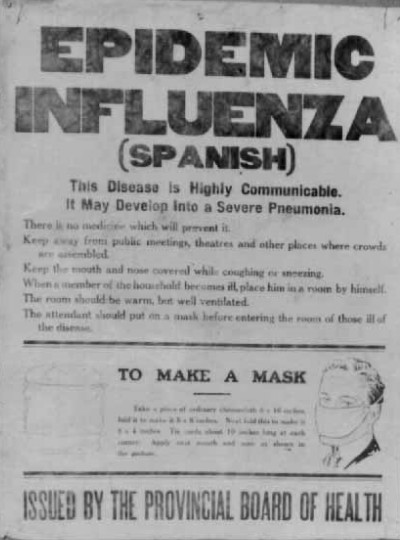
Responding to the guidelines set by the WHO, preparations for the inoculation of millions of people are ongoing, in the Americas, the European Union, in South East Asia and around the World. Priority has been given to health workers, pregnant women and children. In some countries, the H1N1 vaccination will be compulsory.
In the US, the state governments are responsible for these preparations, in coordination with federal agencies. In the State of Massachusetts, legislation has been introduced which envisages hefty fines and prison sentences for those who refuse to be vaccinated. (See VIDEO; Compulsory Vaccination in America?)
The US military is slated to assume an active role in the public health emergency
Schools and colleges across North America are preparing for mass vaccinations. (See CDC H1N1 Flu | Resources for Schools, Childcare Providers, and Colleges)
In Britain, the Home Office has envisaged the construction of mass graves in response to a rising death toll. The British Home Office report calls for “increasing mortuary capacity” An atmosphere of panic and insecurity prevails. (See Michel Chossudovsky Fear, Intimidation & Media Disinformation: U.K Government is Planning Mass Graves in Case of H1N1 Swine Flu Pandemic)

Table contained in an official Home Office Report, reported by the British media. The complete report has not been released
Reliability of the Data
The spread of the disease is measured by country-level reports of confirmed and probable cases.
How reliable is this data. Does the data justify a Worldwide public health emergency, including a $40 billion dollar vaccination program which largely favors a handful of pharmaceutical companies? In the US alone, the costs of H1N1 preparedness are of the order of 7.5 billion dollars.( See Flu.gov: Vaccines, Vaccine Allocation and Vaccine Research)
Following the outbreak of the H1N1 swine flu in Mexico, the data collection was at the outset scanty and incomplete, as confirmed by official statements.( See Michel Chossudovsky, Is it the “Mexican Flu”, the “Swine Flu” or the “Human Flu”? Michel Chossudovsky Political Lies and Media Disinformation regarding the Swine Flu Pandemic)
The Atlanta based Center for Disease Control (CDC) acknowledged that what was being collected in the US were figures of “confirmed and probable cases”. There was, however, no breakdown between “confirmed” and “probable”. In fact, only a small percentage of the reported cases were “confirmed” by a laboratory test.
On the basis of scanty country-level information, the WHO declared a level 4 pandemic on April 27. Two days later, a level 5 Pandemic was announced without corroborating evidence (April 29). A level 6 Pandemic was announced on June 11.
There was no attempt to improve the process of data collection in terms of lab. confirmation. In fact quite the opposite. Following the level 6 Pandemic announcement, both the WHO and the CDC decided that data collection of individual confirmed and probable cases was no longer necessary to ascertain the spread of swine flu. As of July 10, one month after the announcement of the level six pandemic, the WHO discontinued the collection of confirmed cases. It does not require member countries to send in figures pertaining to confirmed or probable cases.
WHO will no longer issue the global tables showing the numbers of confirmed cases for all countries. However, as part of continued efforts to document the global spread of the H1N1 pandemic, regular updates will be provided describing the situation in the newly affected countries. WHO will continue to request that these countries report the first confirmed cases and, as far as feasible, provide weekly aggregated case numbers and descriptive epidemiology of the early cases. (WHO, Briefing note, 2009)
Based on incomplete and scantly data, the WHO nonetheless predicts with authority that: “as many as 2 billion people could become infected over the next two years — nearly one-third of the world population.” (World Health Organization as reported by the Western media, July 2009).
The statements of the WHO are notoriously contradictory. While creating an atmosphere of fear and insecurity, pointing to am impending global public health crisis, the WHO has also acknowledged that the underlying symptoms are moderate and that “most people will recover from swine flu within a week, just as they would from seasonal forms of influenza” (WHO statement, quoted in the Independent, August 22, 2009).
The WHO’s July 10 guidelines have set the stage for a structure of scantiness and inadequacy with regard to data collection at the national level. National governments of member States of the WHO are not required to corroborate the spread of the A H1N1 swine flu, through laboratory tests.
The WHO table below provides the breakdown by geographical region. These figures, as acknowledged by the WHO are no longer based on corroborated cases, since the governments are not required since July 11 to “test and report individual cases”. In an utterly twisted logic, the WHO posits that because the governments of WHO member countries are not required to test and report individual cases, with a view to ascertaining the spread of the virus, that “the number of cases reported actually understates the real number of cases.” (See note at foot of Table). The question is: what is being reported by the countries? How does one ascertain that the reported cases are H1N1 as opposed to seasonal influenza?
Map of affected countries and deaths as of 13 August 2009 [png 313kb]
TABLE
*Given that countries are no longer required to test and report individual cases, the number of cases reported actually understates the real number of cases.
Source WHO | Pandemic (H1N1) 2009 – update 62 (revised 21 August 2009)
The WHO confirms that the above data is based on qualitative indicators:
“The qualitative indicators monitor: the global geographic spread of influenza, trends in acute respiratory diseases, the intensity of respiratory disease activity, and the impact of the pandemic on health-care services.”
These qualitative indicators are, according to the WHO, as follows:
TEXT BOX 1
Geographical spread
Geographical spread refers to the number and distribution of sites reporting influenza activity.
– No activity: no laboratory-confirmed case(s) of influenza, or evidence of increased or unusual respiratory disease activity.
– Localized: limited to one administrative unit of the country (or reporting site) only.
– Regional: appearing in multiple but <50% of the administrative units of the country (or reporting sites).
– Widespread: appearing in ≥50% of the administrative units of the country (or reporting sites).
– No information available: no information available for the previous 1-week period.
• Trend
Trend refers to changes in the level of respiratory disease activity compared with the previous week.
– Increasing: evidence that the level of respiratory disease activity is increasing compared with the previous week.
– Unchanged: evidence that the level of respiratory disease activity is unchanged compared with the previous week.
– Decreasing: evidence that the level of respiratory disease activity is decreasing compared with the previous week.
– No information available.
• Intensity
The intensity indicator is an estimate of the proportion of the population with acute respiratory disease, covering the spectrum of disease from influenza-like illness to pneumonia.
– Low or moderate: a normal or slightly increased proportion of the population is currently affected by respiratory illness.
– High: a large proportion of the population is currently affected by respiratory illness.
– Very high: a very large proportion of the population is currently affected by respiratory illness.
– No information available.
• Impact
Impact refers to the degree of disruption of health-care services as a result of acute respiratory disease.
– Low: demands on health-care services are not above usual levels.
– Moderate: demands on health-care services are above the usual demand levels but still below the maximum capacity of those services.
– Severe: demands on health care services exceed the capacity of those services.
– No information available.
Source: WHO | Annex 4 of the Interim WHO guidance for the surveillance of human infection with A(H1N1) virus
The entire construct involves a non-sequitur.
In the text box below are the qualitative indicators used. What is being tabulated is 1. the spread of influenza, 2. the spread of respiratory diseases and 3. the impacts on health care services activity.
The spread of the H1N1 swine flu is not being evaluated through any concrete indicator.
An examination of the maps (click links on table below) does not suggest any particular pattern or trend, which might ascertain the spread of H1N1.
For many of the reporting countries the information is not available or indicates no particular trend.
The question is: how can this information reasonably be used to ascertain the spread of a very specific form of influenza, namely A H11N1
TEXT BOX 2
Geographic spread of influenza activity during week 31 and 32
Geographic spread of influenza activity during week 31 [png 157kb]
Geographic spread of influenza activity during week 32 [png 269kb]
Trend of respiratory diseases activity compared to the previous week during week 31 and week 32
Trend of respiratory diseases activity compared to the previous week during week 31 [png 155kb]
Trend of respiratory diseases activity compared to the previous week during week 32 [png 266kb]
Intensity of acute respiratory diseases in the population during week 31 and week 32
Intensity of acute respiratory diseases in the population during week 31 [png 153kb]
Intensity of acute respiratory diseases in the population during week 32 [png 262kb]
Impact on health care services during week 31 and week 32
Impact on health care services during week 31 [png 151kb]
Impact on health care services during week 32 [png 259kb]
Source: WHO | Pandemic (H1N1) 2009 – update 62 (revised 21 August 2009)
“Confirmed and Probable Cases” in the US
On July 24, following the WHO July 10 decision to shift from quantitative to qualitative assessments and not to require governments to ascertain the data through lab testing, the Atlanta based CDC also announced that it had discontinued the process of data collection pertaining to “confirmed and probable cases”:
“How many cases of novel H1N1 flu infection have been reported in the United States? When the novel H1N1 flu outbreak was first detected in mid-April 2009, CDC began working with states to collect, compile and analyze information regarding the novel H1N1 flu outbreak, including the numbers of confirmed and probable cases of disease. From April 15, 2009 to July 24, 2009, states reported a total of 43,771 confirmed and probable cases of novel influenza A (H1N1) infection. Of these cases reported, 5,011 people were hospitalized and 302 people died. On July 24, 2009, confirmed and probable case counts were discontinued. Aggregate national reports of hospitalizations and deaths will continue at this time. (See CDC, ,CDC H1N1 Flu | Questions and Answers About CDC’s Online Reporting)
Instead of collecting data –which would have provided empirical backing to its assessments on how the H1N1 virus was spreading– the CDC announced that it had developed a model “to try to determine the true number of novel H1N1 flu cases in the United States”.
“The model took the number of cases reported by states and adjusted the figure to account for known sources of underestimation (for example; not all people with novel H1N1 flu seek medical care, and not all people who seek medical care have specimens collected by their health care provider)….
Why did CDC discontinue reporting of individual cases? Individual case counts were used in the early stages of the outbreak to track the spread of disease. As novel H1N1 flu became more widespread, individual case counts became an increasingly inaccurate representation of the true burden of disease. This is because many people likely became mildly ill with novel H1N1 flu and never sought treatment; many people may have sought and received treatment but were never officially tested or diagnosed; and as the outbreak intensified, in some cases, testing was limited to only hospitalized patients. That means that the official case count represented only a fraction of the true burden of novel H1N1 flu illness in the United States. CDC recognized early in the outbreak that once disease was widespread, it would be more valuable to transition to standard surveillance systems to monitor illness, hospitalizations and deaths. CDC discontinued official reporting of individual cases on July 24, 2009. (Ibid, emphasis added)
Biased Predictions
What is the precise nature of the data transmitted by the states to the CDC? The CDC calls for the transmission of “aggregate national reports of hospitalizations and deaths”.
If the information is conceptually incorrect or incomplete at the outset, predictions and/or simulations will be inevitably be biased.
Without systematic lab confirmation, it is impossible to specify the nature of the virus because the symptoms of H1N1 are broadly similar to those of common influenza. In other words, do the data collected and transmitted by the states to the CDC confirm cases of H1N1 swine flu or do they indicate the prevalence of seasonal influenza?
The CDC posits that the data sent to them by the states is “underestimated”. It then hikes up these figures of “unconfirmed” cases, many of which are cases of seasonal influenza. The “corrected figures” are then inserted into the model:
Using this approach [CDC model], it is estimated that more than one million people became ill with novel H1N1 flu between April and June 2009 in the United States. The details of this model and the modeling study will be submitted for publication in a peer reviewed journal. (Ibid)
The model is then used to predict the spread of swine flu and to justify a national health emergency. “Swine flu could strike up to 40 percent of Americans over the next two years and as many as several hundred thousand could die if a vaccine campaign and other measures aren’t successful.” (Official Statement of the US Administration, Associated Press, 24 July 2009).
Anybody who is familiar with model building and computer simulations, is acutely aware that if the data and assumptions which are fed into the model are incorrect at the outset, the results will inevitably be biased.
What we are dealing with is a process of statistical manipulation, which has far-reaching implications and which could potentially create an atmosphere of panic, particularly if it is coupled, as in the UK, with announcements that “mass graves are being set up to deal with a rising death toll.
Vaccination
The Atlanta based CDC’s model’s simulations and predictions as to the spread of H1N1 swine flu are then used to plan the implementation of a nationwide vaccination program.
Based on the model’s “predictions”, mass vaccination of half of the US population is required, with the possible provision for quarantines under civilian and/or military jurisdiction. In the case of the United Kingdom, confirmed by British press reports, the government has predicted a rising death toll requiring the provision of mass graves.
According to reports, the US government expects to have 85 million doses of the new vaccine by the end of October. In total, the US government has ordered 195 million doses from Big Pharma.
“Recommendation: Priority groups to receive the novel H1N1 vaccine
On July 29, 2009, the Advisory Committee on Immunization Practices (ACIP)—an advisory committee to CDC—recommended that novel H1N1 flu vaccine be made available first to the following five groups (News Release)
Pregnant women Health care workers and emergency medical responders
People caring for infants under 6 months of age
Children and young adults from 6 months to 24 years
People aged 25 to 64 years with underlying medical conditions (e.g. asthma, diabetes)
Combined, these groups would equal approximately 159 million individuals.” (See Flu.gov: Tests, Vaccines, Medications, & Masks
According to the WHO, Western countries have already ordered one billion doses of the vaccine.
“Northern hemisphere countries have so far ordered more than one billion doses of swine flu vaccine, the World Health Organisation said Tuesday, sparking warnings over shortages,” Agence France-Presse reports. While some countries, including Greece, The Netherlands, Canada and Israel, have ordered enough vaccine to inoculate their citizens, “[o]thers, such as Germany, the United States, Britain and France, have put in orders that would cover between 30 and 78 percent of people,” (AFP, August 19, 2009).
The WHO has made similar predictions: “Vaccine makers could produce 4.9 billion pandemic flu shots per year in the best-case scenario”, Margaret Chan, Director-General, World Health Organization (WHO), quoted by Reuters, 21 July 2009)
The United Kingdom: “Suspected Cases” versus “Confirmed Cases”
Even prior to the WHO decision to suspend reporting and compilation of confirmed cases, the process of data collection in the UK revealed some highly unusual patterns.
“There are big gaps in UK data on swine flu, many of them because so few virological confirmations of H1N1 seem to be being undertaken anywhere. But virology matters – and if more tests had been done, we might begin to understand why the number of people in hospital for swine flu in England is so much greater than in Scotland.” Where have all the virologists gone? | Straight Statistics
In Scotland, the collection of data was based on “confirmed cases” (lab testing), whereas in England it was based on “suspected cases” (no lab testing). In both cases, we are dealing with hospitalization. For the same time period, according to the study, England had 3,906 incident hospitalizations for “suspect swine-flu”, compared with Scotland’s 43 for “confirmed H1N1”.
England has approximately ten times more population than Scotland. On a per capita basis, however, there are 9.1 times more people in England with “suspected H1N1” flu than in Scotland, based on “confirmed cases”: 43 confirmed cases in Scotland, 3906 in England (suspected cases), a ratio of more than 1 to 9.
Has the H1N1 epidemic “evolved differently in Scotland and England, in extent and/or timing.”? There is no evidence to this effect. Or is this discrepancy of 9 to 1, partially the result of bias in the data for England which is based on “suspected cases”. Where have all the virologists gone? | Straight Statistics See also Call for more H1N1 data | Straight Statistics
It is on the basis of these “suspected cases” that unsubstantiated and irresponsible statements are being made by senior government health officials.
What this implies is that the hospital based data on “suspected cases” referred to above, which was already the source of bias, is no longer being collected by health personnel.
Self-Categorization
In Britain, the collection of “suspected cases” (which is known to be biased) was abandoned in favor of a system which does not require a diagnosis by a health professional, nor the testing of a lab specimens.
Since the WHO ruling on July 10, establishing new guidelines for data collection, the British authorities no longer focus on hospital based “suspected cases”, they are now collecting the data through “dedicated call centres”.
They have launched a national service where if you have flu like symptoms, you can call up dedicated call centres or check online whether you have swine flu. So, you don’t have to go to your GP, you can access antivirals quickly and don’t infect others by travelling around. (Most rapid spread of H1N1 virus in UK)
In Britain, the transition has been from “confirmed cases” (lab confirmation) to “suspected cases” (established by health professional, not requiring testing) to “self categorization”
As the pandemic progresses, the process of data collection becomes increasingly loose and unprofessional. One would normally expect the opposite, that following the announcement of Worldwide level 6 pandemic, that the process of data collection would be developed and improved as means to formulating a public health action plan. .

The process of data collection under the National Pandemic Flu Service is now based on “self-assessment” or self-categorization. Anybody who thinks he/she has flu-like symptoms can contact the National Pandemic Flu Service, by telephone ou through the internet, and can receive an antiviral prescription (e.g. Tamiflu) without the intermediation of a health professional and without even seeing a doctor. You can do it on the internet or by calling up the phone help line:
“The [British] National Pandemic Flu Service is a self-care service that will assess your symptoms and, if required, provide an authorisation number which can be used to collect antiviral medication from a local collection point. For those who do not have internet access, the same service can be accessed by telephone”
According to British health sources communicated to this author, persons who receive a prescription for Tamiflu through the National Pandemic Flu Service over the phone or through the National Health Service Telephone Call Service will be categorized and recorded as a “suspected case” of H1N1 swine flu.

Typical symptoms: sudden fever (38C or above) and sudden cough
1. Other symptoms include: Tiredness and chills
2. Headache, sore throat, runny nose and sneezing
3. Stomach upset, loss of appetite, diarrhoea
4. Aching muscles, limb or joint pain
Source: NHS and BBC.
The moment you enter your name into the system over the internet or by phone, which allows you to collect anti-viral medication (e.g. tamiflu), you may be categorized as a suspected or probable case of H1N1. (see the UK National Pandemic Flu Service guidelines in Annex 1 below)
As discussed in the England versus Scotland analysis, there is already a 9 to 1 discrepancy between “suspected” and “confirmed” cases, both of which are hospital based.
The system of data collection in the UK through “self-categorization” has no scientific basis whatsoever. It is totally meaningless, given the fact that the H1N1 has the same symptoms as seasonal influenza. (We have, however, not been able to ascertain at the stage the extent to which the self-assessment information is being tabulated and used to establish trends pertaining to the H1N1 flu pandemic)
The pattern in other countries differs from that outlined in relation to Britain. In the US, a system of testing at the state level still prevails.
Concluding Remarks
Reports from Britain by prominent physicians (to the author) suggest that doctors and epidemiologists in the UK are being threatened. They risk being fired by the National Health authorities if they speak out and reveal the falsehoods underlying the data as well as government statements.
It is essential that physicians, epidemiologists and health workers speak out through their respective associations and refute the statements of government health officials who are tacitly acting on behalf of Big Pharma, as well as denounce the manipulation of the data. It is also important to warn the public on the dangers of untested H1N1 flu vaccines.
What we are dealing with is a big lie. A process of generating fake data which is then used to justify a nationwide vaccination program.
The political and corporate interests behind this Worldwide public health emergency must be the target of citizens’ actions.
This public health emergency is not intended to protect humanity.
The World is at the crossroads of a major economic and social crisis. The Worldwide public health emergency serves to divert public opinion from the real crisis which is affecting the World’s people. This crisis is characterised by rising poverty and unemployment and the collapse in social services, not to mention a a US-NATO multitrillion dollar high tech “war without borders” which includes the preemptive “first strike” use of nuclear weapons.
The dramatic causes and consequences of the “real crisis” which in real sense threaten the future of humanity must remain unheralded. Both the Economic Crisis and the Middle East Central Asian war are the object of routine and persistent media distortion and camouflage. In contrast, the H1N1 swine flu –despite its relatively mild and benign impacts– is depicted as major “Save the World” endeavor.
Author and economics professor Michel Chossudovsky is Director of the Centre for Research on Globalization, Montreal, He has taught at universities and academic institutions in North America, Western Europe, Latin America, Asia and the Pacific. He has also worked as a consultant on issues pertaining to public health and the economics of health for the Canadian International Development Agency (CIDA), the United Nations Population Fund (UNFPA), the World Health Organization (WHO) and the Economic Commission for Latin America and the Caribbean (ECLAC). He has also acted as adviser to governments of developing countries.
ANNEX 1
The guidelines of UK National Pandemic Flu Service are indicated below:


